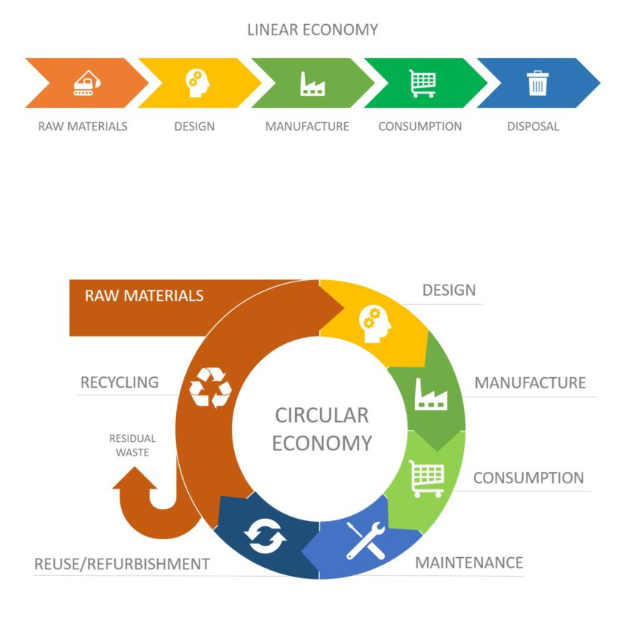What is a Circular Economy?
When we talk about a ‘circular economy,’ we refer to a consumption model that aims to extend the life cycle of products through reusing, repairing, refurbishing, and recycling. The goal is to minimize waste and maximize value. Unlike a traditional “linear economy” where products are made, used, and disposed of, a circular economy keeps materials within the economic system.

The circular economy is based on three principles, driven by design (as defined by The Ellen Macarthur Foundation):
- Eliminate waste and pollution:
- Turning to a circular economy approach means we step away from our current linear economy, whereby we take raw materials, make products and then dispose them as waste, where they end up in landfill or in incinerators.
- Circulate products and materials (at their highest value):
- This refers to keeping materials in use, either as a product or when it can no longer be used, as a material. This means nothing ends up as waste and the value can be retained.
- Regenerate nature:
- By transitioning to a circular economy, we support natural processes and leave more room for nature to thrive.
Implementation of the Circular Economy
Here is a summary of what can be done at each stage of a products’ life at each stage of the circular economy:
- Design – when designing a product, it can be designed with ‘less waste’ in mind. For example, this can mean designing products so that they are efficient and long-lasting. This can also mean designing with other stages of the circular economy in mind e.g. designing so excess materials don’t need to be ordered at the manufacture stage, or designing an item so it can be repaired when it gets to the end of its life.
- Manufacture – During the manufacturing stage, producers can utilise materials from products that have reached the end of their life, rather than relying solely on raw materials.
- Consumption – Consumers can embrace the circular economy by choosing products that are designed and built to last. We can opt for items that can be used multiple times and, when no longer needed, can be recycled or reused.
- Maintenance – Encouraging the maintenance and repair of items can significantly extend their lifespan, thus reducing waste production.
- Reuse/refurbishment – Reusing or refurbishing items when they are reaching the end of their life can restore their value and repurpose them. This reduces the need to purchase new items and minimises waste.
- Recycling – Recycling an item at the end of its life, means that the value of materials can be used in the production of new items, rather than being disposed of.
These principles can help us move away from a linear economy and help us to operate in a more circular way.
Incorporating a Circular Economy into everyday life
Let’s put this into perspective of everyday items we all use… clothes! Here are some questions that can be asked at every stage of the circular economy cycle, for clothing:
- Design – Can the designer or brand produce the item with less waste in mind? Can they use recycled materials? Can they package their items in recycled materials? Or ship them to a store in reusable packaging? Can we make our designs efficient, so we don’t need to order excess materials?
- Manufacture – Can the item of clothing being produced be made in a way that produces little to no offcuts?
- Consumption – Can we consume clothes so we don’t buy what we don’t need, or something we will only wear once? Can we wear this item of clothing multiple times, and make it last a long time?
- Maintenance – If the piece of clothing has ripped, can we repair it so that we can continue to wear it?
- Reuse/refurbishment – If the piece of clothing can no longer be worn, can we reuse it as something else?
- Recycling – If the item is still in good condition, can we sell on our item of clothing so that someone else can get the use out of it, rather than just throwing it away? Or can we donate the item of clothing to someone in need?
Embracing a this mindset encourages us to consider every stage of the cycle rather than simply designing, using, and discarding items.
Interested in a free discovery call about embracing a circular economy? Get in touch with Lucy today.




